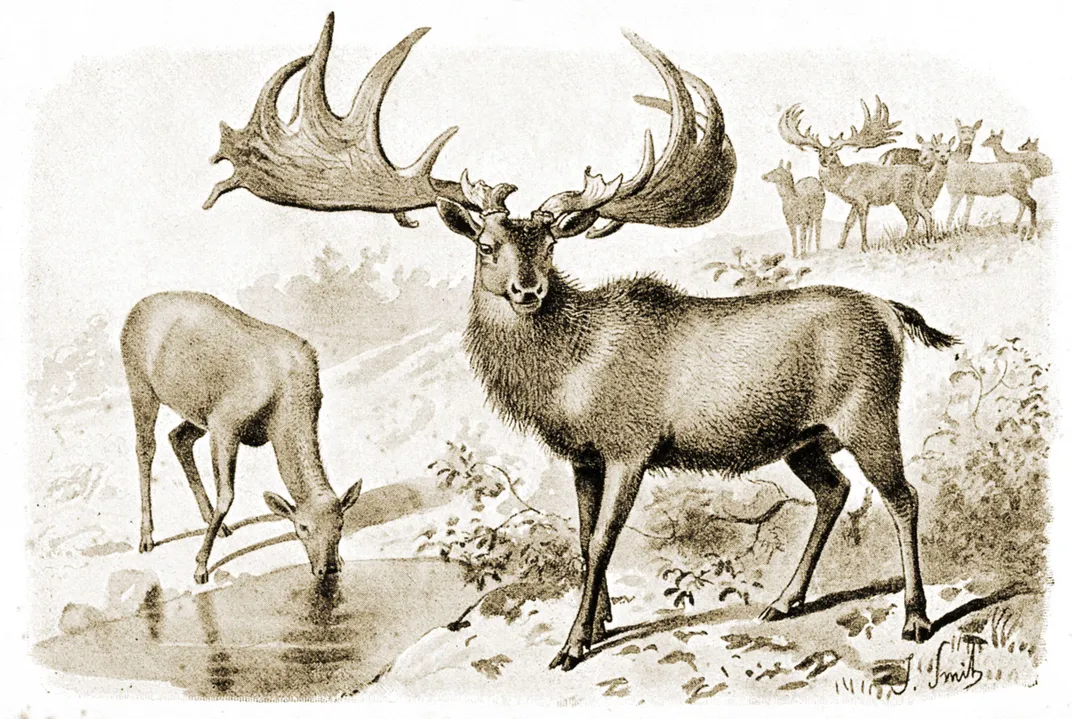Biggest. Antlers. Ever. Meet the Irish Elk
On view at the Smithsonian’s Natural History Museum, this specimen of the extinct species unlocks an evolutionary mystery
/https://tf-cmsv2-smithsonianmag-media.s3.amazonaws.com/filer/ed/65/ed65e093-7848-4b1d-806e-a1c603ba7b6f/jun2021_c02a_prologue-recovered.jpg)
Some 17,000 years ago, on a wall of Lascaux cave in southwestern France, an artist made a painting of a deer with fantastically elongated antlers. To modern eyes, it looks like an exaggeration or a parody, but it was an accurate representation of an animal that early Europeans knew well. Today we call it the Irish elk, or Megaloceros giganteus.
The biggest males weighed 1,500 pounds, about the same as an Alaskan moose, and they sported the largest antlers the world has ever known—12 feet across, weighing almost 90 pounds. They were shed and regrown annually. The females were 10 to 15 percent shorter than the males, without antlers.
As a name, Irish elk is a double misnomer. The animal thrived in Ireland but was not exclusively Irish, ranging across Europe to western Siberia for some 400,000 years during the Pleistocene. Nor was it an elk; it was a giant deer, with no relation to the European elk (Alces alces) or North American elk (Cervus canadensis). The evolution of its most striking feature was driven by sexual selection; no survival advantages derived from such enormous antlers. “It was all about impressing the females,” says Adrian Lister, a paleobiologist at the Natural History Museum in London, England, and a leading expert on the species.
For centuries, scientists thought the antlers were only for display, but two recent studies demonstrate they were also used for fighting. “By lowering their heads,” Lister says, “two rival males would interlock the lower parts of their antlers, and then push, twist, shove. The females would mate with the winners.”

Lister has spent more than 25 years of his career researching M. giganteus. “It was one of the most celebrated extinct animals, up there with T. Rex and the mammoth, yet relatively little was known about it, and much of that was wrong,” he says. In the 19th and early 20th centuries, the Irish elk was the textbook example of orthogenesis, the now-discredited theory that evolution proceeded in straight lines that could not be stopped, even when they led to disaster. Proponents thought the Irish elk’s antlers got too big and heavy, causing males to get tangled in trees and sink into bogs and lakes.
Lister’s mapping, dating and pollen research show that the problem was climate change. The animals died out in Western Europe during a time of rapid cooling known as the Younger Dryas, which lasted from roughly 13,000 to 12,000 years ago. The giant deer required abundant, mineral-rich grasses, leaves and shoots, and such vegetation went into drastic decline as temperatures rapidly cooled. “The males would have really struggled, having to grow those antlers every year,” says Lister. But the cold spell’s impact on females may have been the deciding factor, according to a 2008 study by C.O. Worman and Tristan Kimbrell, who said the “ability to produce and nurse living young is strongly tied to the female’s nutritional status.” As landscapes turned to ice and tundra, herd sizes would have been reduced until the animals dwindled away.
In Russia, M. giganteus survived until roughly 8,000 years ago, when warming temperatures turned the semi-open country favored by the deer into dense forest. “In both places—Western Europe and Russia—Neolithic humans were showing up at the time of extinction,” says Lister. “It’s possible, but unproven, that hunting finished off the already doomed populations.”
Humans forgot all about this giant deer until the late 1500s and early 1600s, when Irish peasants, digging in bogs for peat to burn as fuel, started finding their fossilized remains. Kings and nobles prized the giant antlers. King Charles II of England had a set mounted on the walls of Hampton Court Palace, where they remain, and the skulls and antlers of Irish elk still adorn the walls of castles and lodges in Ireland today.
The specimen in the photograph is the Smithsonian’s oldest mounted fossil skeleton, first displayed in 1872. It’s one of the most popular exhibits in the Natural History Museum today, says Siobhan Starrs, project manager for the Deep Time exhibition in the David H. Koch Hall of Fossils.
For more than a century, the skeletal Irish elk stood exhibited at its full height, its antlers suspended from wires attached to the ceiling. Since 2019, it has been lying down in a resting pose. This placement brings the antlers down to the sightline of a child. “They look absolutely gigantic up close,” Starrs says, “which our younger visitors really appreciate.”